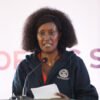
Photos of scientists (L-R) Martin Karplus, Michael Levitt and Arieh Warshel are shown at a press conference to announce the winners of the 2013 Nobel Prize in Chemistry on October 9, 2013 at the Royal Swedish Academy of Sciences in Stockholm/AFP
Stockholm October 9- Three scientists won the Nobel Prize for Chemistry on Wednesday for developing computer models to simulate chemical processes, providing a revolutionary tool for drug designers and engineers.
Martin Karplus, a US Austrian citizen, Michael Levitt, a US British citizen, and Arieh Warshel of the US and Israel were honoured “for the development of multiscale models for complex chemical systems,” the Nobel jury said.
The three were being recognised for “taking the experiment to cyberspace,” it added.
Chemists all over the world simulate complex experiments on their computers thanks to work by the trio that dates back to the 1970s, the Royal Swedish Academy of Sciences said in a statement.
“I was doing work before my post doc when I was 20 years old to write a computer programme. I guess I wrote a pretty good programme,” Levitt, now 66, told AFP by telephone from his California home.
He said that it was “essentially” this programme that lay at the core of Wednesday’s Nobel prize, and people benefitted from it to this day.
“I was speaking to a doctoral student yesterday and he was able to do a calculation that used to take two hours and now takes a 100th of a second,” Levitt said. “It makes a huge difference!”
The Nobel jury said the tool is “universal”, helping pharmaceutical engineers to design new drugs or engineers to make cleaner energy sources or smarter manufactured products.
The three combined classical physics with quantum physics two previously rival worlds in computer models designed to predict chemical reactions.
Such reactions can take place, for instance, between industrial chemicals or in biological functions, when an enzyme cuts a protein, a virus penetrates a cell or or a cell divides.
The processes can happen in a fraction of a millisecond, defeating conventional algorithms that try to map them step by step.
By including quantum physics in the computational mix, the number of permutations for calculation rises hugely, as they incorporate the possibility that an atom is in one of several of the famously fickle quantum states at any time in the processes.
This also requires enormous computer power to crunch the data.









































